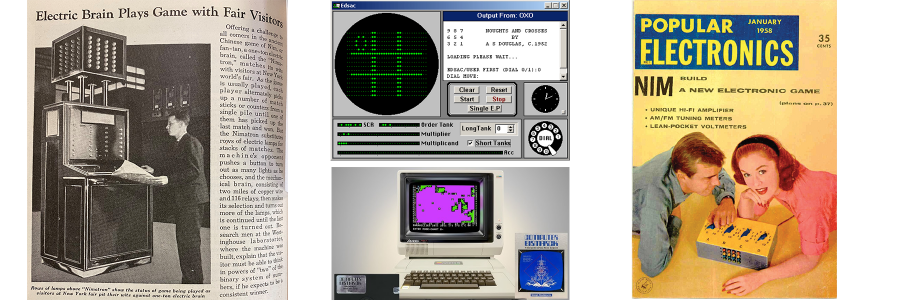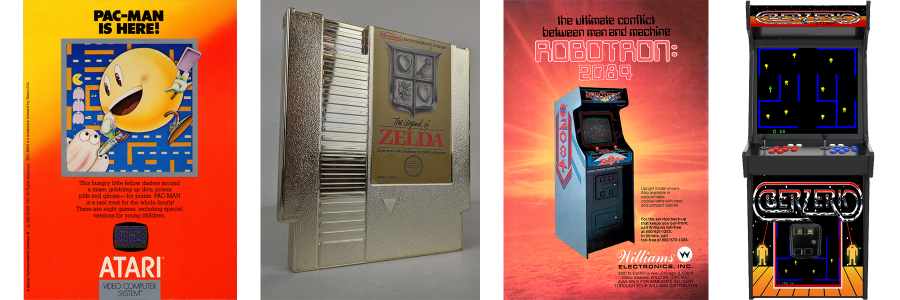The Long History of Artificial Intelligence in Video Games
Artificial Intelligence (AI) may feel like a hot topic in today’s tech-driven world, but in the realm of video games, AI has been quietly shaping player experiences for decades. From the rudimentary mechanics of early arcade games to the mind-blowing adaptive systems of modern gaming, AI has been a cornerstone of the medium since its inception. Let’s take a journey through the history of AI in video games, exploring how it began, how it evolved, and where it’s heading.

The Origins of AI in Games: Nim, OxO, and Computer Bismarck
The first inklings of AI in games came long before the home console era. In the 1950s and 1960s, computer scientists were already experimenting with AI as a tool to mimic human decision-making:
- Nim (1940s/1951): Nim was one of the earliest examples of a game featuring AI. Created for the Nimatron computer, it was a mathematical game where players removed objects from piles according to specific rules. The computer could calculate moves that made it nearly unbeatable, showcasing basic decision-making algorithms.
- OxO (1952): Developed by Alexander S. Douglas for the EDSAC computer, OxO was essentially a digital version of Tic-Tac-Toe. The AI used a straightforward algorithm to calculate its moves, making it a notable early example of computer-driven game behavior.
- Computer Bismarck (1980): One of the earliest commercial computer wargames, developed by Strategic Simulations, Inc., this game used AI to control naval units during World War II scenarios. The AI’s role was to simulate complex tactical decisions, marking a leap forward in gaming sophistication.
These early experiments paved the way for AI to be incorporated into the games we know and love.

AI in the 1970s: A Step Toward Real-Time Interactions
The 1970s saw the emergence of AI-driven gameplay in the arcade and early home console markets. While the capabilities were still rudimentary, the foundations of interactive gameplay were laid during this era:
- Pong (1972): While not AI in the traditional sense, the computer-controlled paddle in Pong introduced the idea of a non-human opponent adapting to player actions. This rudimentary “AI” made one-on-one gaming possible without needing another human.
- Hunt the Wumpus (1973): A text-based game created by Gregory Yob, this early computer game featured a logic-based AI system that determined the placement of hazards like bats and pits, as well as the location of the Wumpus creature.
- Space Invaders (1978): One of the most iconic arcade games of all time, Space Invaders introduced simple AI routines for enemy movement. As players destroyed invaders, the remaining enemies would speed up—an unintended yet brilliant feature that added tension and excitement to the gameplay.

AI in the 1980s: From 8-Bit to Innovation
The 1980s saw AI start to mature as developers explored new ways to use it, especially as home consoles like the Atari 2600 and NES became popular.
- Pac-Man (1980): Each ghost in Pac-Man was programmed with its own AI personality, dictating how it chased or avoided the player. For example, “Blinky” aggressively pursued the player, while “Clyde” alternated between chasing and retreating. This added strategic depth to a seemingly simple game.
- The Legend of Zelda (1986): Zelda introduced enemy AI that reacted to the player’s movements and actions, with some enemies actively avoiding the player’s attacks. This paved the way for more complex enemy behaviors in action-adventure games.
- Robotron: 2084 (1982): Developed by Eugene Jarvis and Larry DeMar, this twin-stick shooter showcased AI-driven enemies that could swarm, flank, and overwhelm players with coordinated movements, creating chaotic yet strategic gameplay.
- The Atari 2600 Era: Games like Combat (1977) used AI to create enemy tanks and planes with limited intelligence, and Berzerk (1980) introduced hostile robots with random movement patterns and the ability to chase the player.
AI was primarily used to simulate non-human opponents, creating challenges and ensuring replayability. It was also a tool to adapt gameplay in real-time, even if the complexity was still limited.

AI in the 1990s: The Leap to Sophistication
The 1990s brought rapid advancements in gaming technology, and AI was no exception. Developers used more complex algorithms to create smarter opponents and immersive worlds:
- Mortal Kombat (1992): Fighting game AI became increasingly reactive, learning to counter player moves and adapt to different play styles.
- Doom (1993): AI-controlled demons exhibited basic pathfinding, stalking players through 3D environments. This use of AI in first-person shooters set a standard for enemy behavior in future games.
- Command & Conquer (1995): This real-time strategy game used AI to manage resource collection, troop deployment, and battlefield tactics. It gave players a sense of competing against a thinking opponent.
- Metal Gear Solid (1998): This stealth game introduced AI enemies that patrolled areas, responded to noise, and pursued the player when spotted, creating an unprecedented level of tension.

Modern AI in Games: Adaptive, Realistic, and Immersive
In recent years, AI in video games has reached astonishing levels of complexity:
- The Last of Us (2013): Enemy AI in The Last of Us adapts to player behavior, using flanking tactics, seeking cover, and retreating when outmatched. The AI’s actions add realism and tension to the game.
- Alien: Isolation (2014): The Xenomorph in Alien: Isolation features an AI system that “learns” the player’s patterns. It stalks the player unpredictably, creating an atmosphere of constant dread.
- Red Dead Redemption 2 (2018): NPCs in Rockstar’s open-world Western have AI routines that simulate daily lives, reacting dynamically to the player’s actions. This creates a living, breathing world that feels truly immersive.
- DeepMind in StarCraft II (2019): Google’s DeepMind AI achieved groundbreaking results by mastering StarCraft II, demonstrating the potential for machine learning in gaming.
AI as a Tool: Why Game Developers Use It
From the beginning, game developers used AI to make games challenging and engaging. Key reasons include:
- Simulating Human Opponents: AI fills the role of non-human players in single-player modes.
- Enhancing Replayability: Adaptive AI ensures games feel fresh on repeat playthroughs.
- World-Building: AI brings NPCs and game worlds to life, making them more immersive and interactive.

Progressive Leaps in AI for Games
Some developers and games have made groundbreaking advancements in AI:
- Black & White (2001): Lionhead Studios used AI to create a god simulator where the player’s actions shaped the behavior of in-game creatures.
- No Man’s Sky (2016): Procedural generation, a form of AI, created an entire universe of planets, flora, and fauna for players to explore.
The Future of AI in Games
The future of AI in gaming is bright, with exciting developments underway:
- Procedural Storytelling: AI-driven narratives that adapt to player choices could redefine storytelling in games.
- Enhanced NPC Behavior: AI could create NPCs with more realistic personalities, emotions, and goals.
- AI-Generated Content: Games like Minecraft already use AI to create worlds. Future games may use it to create everything from landscapes to quests dynamically.
AI in Games: Nothing to Fear
While AI might seem like a new frontier, it’s been a part of gaming for decades, steadily advancing and enriching the player experience. Far from being scary or negative, AI has helped make games more immersive, engaging, and fun. As we look to the future, AI will continue to evolve, offering limitless possibilities for how we play and interact with games.




